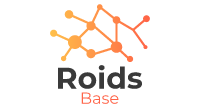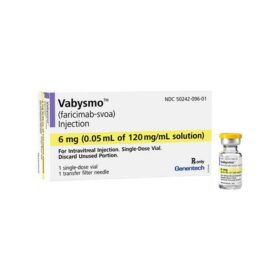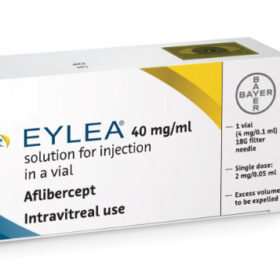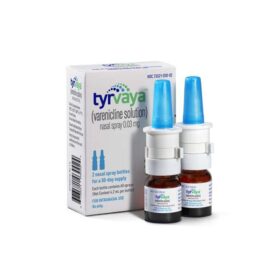- Your cart is empty
- Continue Shopping

Product
Buy Tepezza (teprotumumab-trbw) Online
$19,635.00
DISEASE INDICATIONS: Thyroid Eye Disease
MANUFACTURER: Horizon Therapeutics plc
USAGE: Intravenous
MEDICINE APPROVED BY:
Food and Drug Administration (FDA)
Tepezza (teprotumumab-trbw) is used to treat Thyroid Eye Disease (TED), otherwise known as Grave’s Eye Disease, when the condition is in its active phase.
What is Tepezza (teprotumumab-trbw) for?
Tepezza (teprotumumab-trbw) is a prescription medication used to treat Thyroid Eye Disease (TED), a rare autoimmune disease that affects the eyes and may cause them to protrude, become dry, red, and swollen. Tepezza works by inhibiting the activity of a specific protein (insulin-like growth factor-1 receptor) that is responsible for the expansion of the tissues behind the eyes, reducing eye bulging and improving other symptoms of TED. It is used in adults who have active moderate-to-severe TED.
How does Tepezza (teprotumumab-trbw) work?
Tepezza (teprotumumab-trbw) works by inhibiting the activity of a protein called insulin-like growth factor-1 receptor (IGF-1R), which is overexpressed in the tissues behind the eyes of patients with Thyroid Eye Disease (TED). This protein is involved in the expansion of these tissues, leading to eye bulging, dryness, redness, swelling, and other symptoms.
By blocking the activity of IGF-1R, Tepezza reduces inflammation and the accumulation of immune cells and fluid in the tissues, leading to a reduction in eye protrusion, and improving other symptoms of TED.
Tepezza is a monoclonal antibody that specifically targets IGF-1R and is administered intravenously every three weeks for a total of eight infusions. It is designed to bind to the protein and inhibit its activity, thereby slowing the progression of the disease and improving the quality of life of patients with active moderate-to-severe TED.
How is Tepezza (teprotumumab-trbw) taken?
The recommended dosing regimen for Tepezza (teprotumumab-trbw) is as follows:
– For the initial dose, 10 mg/kg of body weight is administered.
– Subsequently, a dose of 20 mg/kg of body weight is given every three weeks for a total of 7 additional infusions.
– Tepezza is administered as an intravenous infusion into a vein.
For detailed information on dosage and administration, please refer to the official prescribing information included in our references section. It is advisable to consult with a healthcare provider to determine a personalized dosing regimen.
Are there any known side effects of Tepezza (teprotumumab-trbw)?
Yes, there are known side effects of Tepezza (teprotumumab-trbw). Some common side effects of Tepezza include:
– Muscle spasms
– Nausea
– Hair loss
– Fatigue
– Headache
– Diarrhea
– Dry skin
– High blood sugar
– Weight loss
– Insomnia
Less common but more serious side effects may include:
– Infusion reactions, such as rash, itching, difficulty breathing, and low blood pressure
– Changes in vision
– Liver injury
– Worsening of hyperthyroidism
– Low levels of blood platelets
– Increased risk of infection
– Rarely, Tepezza may cause cancer
It is important to report any side effects or concerns to a healthcare provider. They can recommend ways to manage side effects or determine if Tepezza is still safe to use. It is advisable to inform a healthcare provider of any pre-existing medical conditions or ongoing medications before starting Tepezza treatment.
Clinical trials
Tepezza (teprotumumab-trbw) was granted FDA approval for treating Thyroid Eye Disease (TED) based on two studies, Study 1 (NCT01868997) and OPTIC (NCT03298867). Study 1 was conducted with 88 active TED patients who received teprotumumab-trbw treatment once every three weeks intravenously for eight infusions under a randomized, placebo-controlled trial. OPTIC was a multicenter, parallel-group, double-masked, randomized, placebo-controlled study with 76 TED patients who were given eight infusions of teprotumumab or placebo over 24 weeks, including the baseline and visits until the 24th week.
Both studies assessed reduction of eye bulging as the primary efficacy outcome, defined as decreasing 2 points or more in the Clinical Activity Score (with a score of ≥3 indicating active disease) and decreasing 2 mm or more in eye bulging by week 24. The results of the studies indicated that teprotumumab-trbw reduces eye bulging, rapidly improves TED symptoms. According to the studies, 69% of TED patients receiving teprotumumab-trbw showed a response at week 24 in Study 1, while 78% showed a response in OPTIC. In Study 1, patients who received teprotumumab-trbw had a reduction of eye bulging by an average of 2.82 mm compared to 0.54 mm in patients receiving placebo. The onset of treatment effect was noticeable after six weeks in Study 1 and promptly visible in all follow-up weeks in OPTIC. For a comprehensive overview of Tepezza’s effectiveness and safety, please see the summary of product characteristics in the resource section.
Additional Information
| Package | Vial with 500 mg powder |
|---|










Reviews
There are no reviews yet.